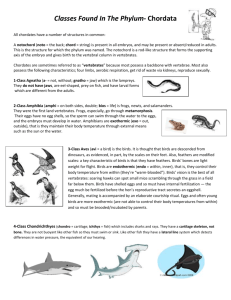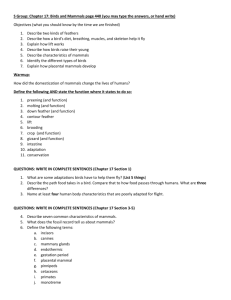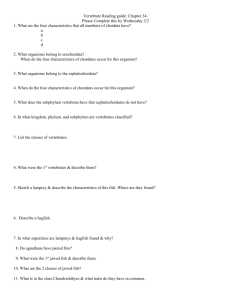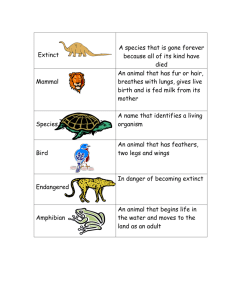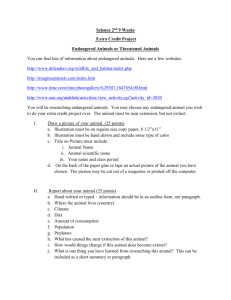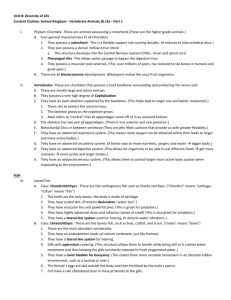Animals
advertisement
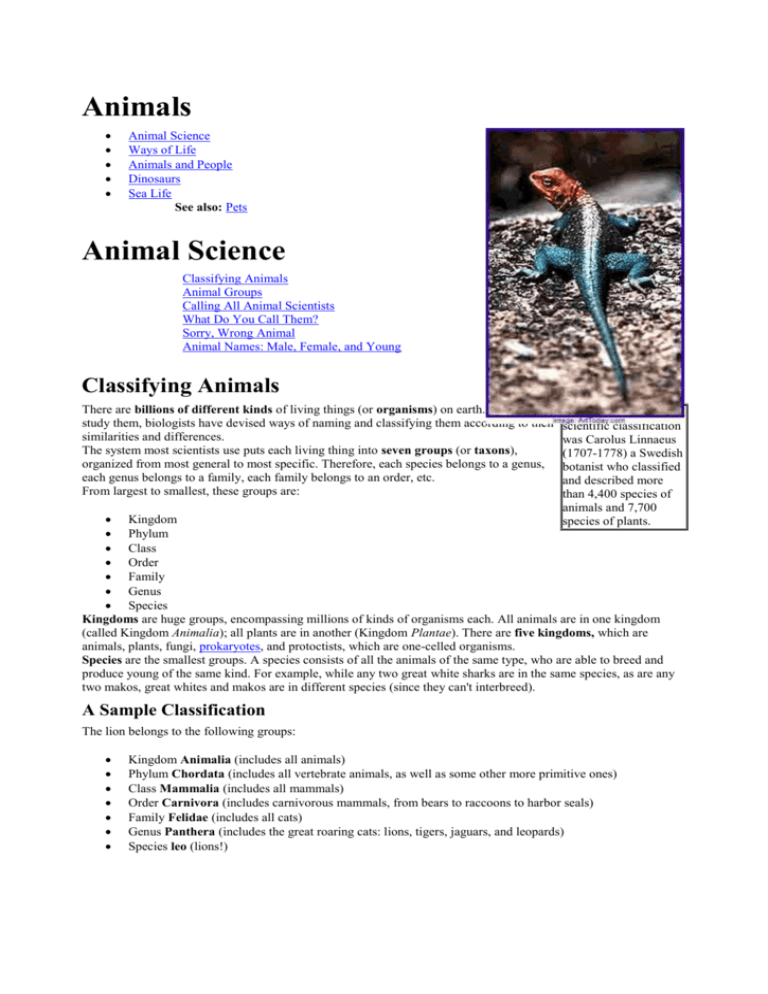
Animals Animal Science Ways of Life Animals and People Dinosaurs Sea Life See also: Pets Animal Science Classifying Animals Animal Groups Calling All Animal Scientists What Do You Call Them? Sorry, Wrong Animal Animal Names: Male, Female, and Young Classifying Animals There are billions of different kinds of living things (or organisms) on earth. To help study them, biologists have devised ways of naming and classifying them according to their similarities and differences. The system most scientists use puts each living thing into seven groups (or taxons), organized from most general to most specific. Therefore, each species belongs to a genus, each genus belongs to a family, each family belongs to an order, etc. From largest to smallest, these groups are: The inventor of modern scientific classification was Carolus Linnaeus (1707-1778) a Swedish botanist who classified and described more than 4,400 species of animals and 7,700 species of plants. Kingdom Phylum Class Order Family Genus Species Kingdoms are huge groups, encompassing millions of kinds of organisms each. All animals are in one kingdom (called Kingdom Animalia); all plants are in another (Kingdom Plantae). There are five kingdoms, which are animals, plants, fungi, prokaryotes, and protoctists, which are one-celled organisms. Species are the smallest groups. A species consists of all the animals of the same type, who are able to breed and produce young of the same kind. For example, while any two great white sharks are in the same species, as are any two makos, great whites and makos are in different species (since they can't interbreed). A Sample Classification The lion belongs to the following groups: Kingdom Animalia (includes all animals) Phylum Chordata (includes all vertebrate animals, as well as some other more primitive ones) Class Mammalia (includes all mammals) Order Carnivora (includes carnivorous mammals, from bears to raccoons to harbor seals) Family Felidae (includes all cats) Genus Panthera (includes the great roaring cats: lions, tigers, jaguars, and leopards) Species leo (lions!) Animal Groups Vertebrates and Invertebrates Almost all animals fall into one of two groups. Adult vertebrates have a spinal column, or backbone, running the length of the body; invertebrates do not. Vertebrates are often larger and have more complex bodies than invertebrates. However, there are many more invertebrates than vertebrates. Vertebrates Warm-blooded animals regulate their own body temperatures; their bodies use energy to maintain a constant temperature. Coldblooded animals depend on their surroundings to establish their body temperatures. Fish breathe through gills, and live in water; most are cold-blooded and lay eggs (although sharks give birth to live young). Amphibians are cold-blooded and live both on land (breathing with lungs) and in water (breathing through gills) at different times. Three types of amphibians are frogs and toads, salamanders, and caecilians. Caecilians are primitive amphibians that resemble earthworms. They are found in the tropics. Reptiles are cold-blooded and breathe with lungs. They have scales, and most lay eggs. Reptiles include snakes, turtles and tortoises, crocodiles and alligators, and lizards. Dinosaurs were reptiles, although some scientists believe that some were warm blooded. Birds are warm-blooded animals with feathers and wings. They lay eggs, and most can fly (although many, including penguins and ostriches, cannot). Mammals are warm-blooded, and are nourished by their mothers' milk; most are born live (however, the platypus lays eggs). Most mammals also have body hair. Invertebrates Sponges are the most primitive of animal groups. They live in water (usually saltwater), are sessile (do not move from place to place), and filter tiny organisms out of the water for food. Coelenterates are also very primitive. Their mouths, which take in food and get rid of waste, are surrounded by stinging tentacles. Some coelenterates are jellyfish, corals, and sea anemones. Echinoderms include starfish, sea urchins, and sea cucumbers. They live in seawater and have external skeletons. Worms come in many varieties and live in all sorts of habitats — from the bottom of the ocean to the inside of other animals. They include flatworms (flukes), roundworms (hookworms), segmented worms (earthworms), and rotifers (philodina). Mollusks are soft-bodied animals, which often live in hard shells. They include snails, slugs, octopus, squid, mussels, oysters, clams, scallops, chitons, and cuttlefish. Mollusks are the second-largest group of invertebrates, with 50,000 living species. Arthropods are the largest and most diverse of all animal groups. They have segmented bodies supported by a hard external skeleton (or exoskeleton). Arthropods include insects, arachnids (spiders and their relatives), centipedes, millipedes, and crustaceans like crabs, lobsters, and shrimp. Calling All Animal Scientists A person who specializes in the study of animals is called a zoologist. Zoologists who study certain kinds of animals have their own names. Anthropologists study human beings. Entomologists study insects. Herpetologists study reptiles and amphibians. Ichthyologists specialize in fish. Malacologists study mollusks, like snails and clams. Mammalogists specialize in mammals. Nematologists study round worms. Ornithologists study birds. Ethologists study animal behavior. What Do You Call Them? Although these words sound scientific, they are commonly used to describe animal families or behavior. Herbivores are animals, such as deer, who eat plants. Carnivores are flesh-eating animals, like lions. Omnivores, such as bears and humans, eat both meat and plants. Invertebrates are animals without backbones, such as worms and insects. Vertebrates are animals with backbones. Reptiles, amphibians, birds, and mammals are all vertebrates. Marsupials are families of mammals, such as kangaroos and opossums, whose females carry their young in an external pouch. Monotremes are rare mammals, such as the platypus and echidna (or “spiny anteater”), that lay eggs. Nocturnal animals, such as owls, are active at night. Diurnal animals, such as squirrels, are awake during the day. Pinnipeds are aquatic mammals with flippers, like seals and walruses. Quadrupeds are animals with four feet, such as cows. Bipeds, like humans and gorillas (and some dinosaurs!), walk upright on two legs. Primates include humans and their closest mammalian relatives. They share flexible arms and legs, skilled fingers (and sometimes toes), and relatively big brains. The many species of apes, monkeys, and lemurs are among the primates. Cetaceans are ocean mammals, including whales and dolphins. Rodents, like squirrels and gerbils, have large front teeth for gnawing and cheek teeth for chewing. Arachnids are arthropods, such as spiders, scorpions, mites, and ticks. Sorry, Wrong Animal The American buffalo is not a buffalo; it is a bison. IMSI Master Clips The bald eagle is not bald; it has a cap of white feathers on top of its head. arttoday.com The koala is not a bear; it is a marsupial, which is a mammal with a pouch. arttoday.com The Komodo dragon is not a dragon; it is a lizard. The prairie dog is not a dog; it is a rodent similar to a squirrel. The sea horse is not a horse; it is a fish. Copyright John White, used with permission The titmouse is not a mouse; it is a bird. Animal Names: Male, Female, and Young Animal Ass Bear Cat Cattle Chicken Deer Dog Duck Male Jack Boar Tom Bull Rooster Buck Dog Drake Female Jenny Sow Queen Cow Hen Doe Bitch Duck Young Foal Cub Kitten Calf Chick Fawn Pup Duckling Elephant Bull Cow Calf Fox Dog Vixen Cub Goose Gander Goose Gosling Horse Stallion Mare Foal Lion Lion Lioness Cub Rabbit Buck Doe Bunny Sheep Ram Ewe Lamb Swan Cob Pen Cygnet Swine Boar Sow Piglet Tiger Tiger Tigress Cub Whale Bull Cow Calf Wolf Dog Bitch Pup Source: James G. Doherty, General Curator, The Wildlife Conservation Society. Ways of Life Where in the World Do Animals Live? Scavengers Animal Senses Animal Communication An International Guide to Animal Talk The Big Sleep Animals on the Move Animal Partnerships Animal Arsenal Animals that Regenerate Speed of Animals Animal Dads Gestation, Incubation, and Longevity of Certain Animals Fantastic Animal Facts Animal FAQs What's that Animal Number? Extinct, Endangered and Threatened Species Why Do Animals Become Endangered? Threatened and Endangered Species Animal Group Terminology Where in the World Do Animals Live? Animals live only where they can survive. Koala bears, for example, eat only the leaves of certain eucalyptus trees, so they must live in Australia, where these trees grow. All of the animals listed below can survive in only one place on earth — and many of them are endangered. North America Alligator, Arctic fox, Arctic tern, Bald eagle, Bison, California condor, California sea tern, Dall sheep, Musk ox, North American grey squirrel, Raven, Snapping turtle, Wild turkey South America Alpaca, Darwin's finch, Flightless cormorant, Giant tortoise, Llama, Maned wolf, Marine iguana, Sloth, Torrent duck, Toucan, Vicuña Europe Reindeer, Scottish wildcat, Wild goat Africa Aardvark, Aardwolf, Aye-aye, Camel, Chimpanzee, Giraffe, Green gecko, Hippopotamus, Hyena, Indri, Lion, Rufed lemur, Spitting cobra, Tsetse fly Asia Asiatic lion, Giant panda, Komodo dragon, Przewalski's horse, Snow leopard, Zeren Australia and New Zealand Archie's frog, Dingo, Duck-billed platypus, Emu, Kakapo, Kiwi, Koala, Quokka, Short-nosed rat kangaroo, Short-tailed wallaby, Tasmanian devil Antarctica Adélie penguin, Penguin, Ross seal, Weddell seal Scavengers Scavengers are animals that feed on dead or injured animals. Scavengers are not usually held in high esteem, but they have a job to do: they clean the earth of organic garbage. Carrion, a favorite treat of scavengers, is the flesh of dead and rotting animals. Five Birds That Scavenge California condors eat the remains of dead animals. Crows can be seen eating small mammals, like squirrels, that have been killed on roads. Marabou storks of the Eastern Hemisphere travel with vultures and hyenas, and eat dead fish, reptiles, and other animals — even elephants. Seagulls like to hunt fish, insects, and earthworms, but will also eat carrion and go through garbage for food. Vultures are not the same as buzzards. Buzzards are a kind of hawk; vultures form their own family. IMSI Master Clips Vultures are full-time scavengers. arttoday.com Three Fish That Scavenge Young marine eels will eat dead fish and crustaceans. Remoras swim near large fish and sharks and eat their leftovers. Sharks keep the ocean clean by eating dead or wounded fish. Seven Mammals that Scavenge Bears often follow ravens in order to find dead fish to eat. Alaskan brown bears feed on dead seals, walruses, and whales that have floated ashore. IMSI Master Clips Hyenas hunt and scavenge in packs. African villagers often leave their garbage out for hyenas to eat. arttoday.com Jackals (African wild dogs) often scavenge in packs beside hyenas. Leopards, like lions, will scavenge when their hunting is unsuccessful. Lions are great predators but will often scavenge or steal prey caught by other animals. Raccoons eat garbage from dumps and cans, especially if it smells of chicken or fish. IMSI Master Clips Rats will eat almost anything. Animal Senses As humans, we get by with five senses: touch, taste, sight, smell, and hearing. They work well for us, but other animals have developed many other strange and wonderful ways to find their way around. Some dolphins, whales, and bats navigate and track prey using echo location. This is a very advanced form of hearing that allows them to “see” their surroundings by listening to and analyzing the way sound reflects off objects in their environment. Many fish sense their surroundings with a lateral line system, which detects changes in water pressure. This allows them to feel the movement of other animals in the water nearby. Snakes use a special apparatus called Jacobsen's organ to smell. The snake's forked tongue collects chemicals from the air, which it pulls in and holds against the organ, located in the roof of its mouth. Sharks, and some other fish are sensitive to the electric fields generated by other animals in the water. They use this information to track prey. Weak electric currents are sometimes used to repel sharks. Animal Communication Most animals (including people) use “body language” as well as sound and smell in order to communicate with one another. Here are some of the ways animals express themselves. Many animals communicate by smell: they release pheromones (airborne chemicals) to send messages to others. Pheromones play an important part in reproduction and other social behavior. They are used by many animals, including insects, wolves, deer, and even humans! Bees dance when they have found nectar. The scout bee will dance in the hive, and the dance directs other bees to the location of the nectar. IMSI Master Clips Chimpanzees greet each other by touching hands. Male fiddler crabs wave their giant claw to attract female fiddler crabs. White-tailed deer show alarm by flicking up their tails. Dogs stretch their front legs out in front of them and lower their bodies when they want to play. Elephants show affection by entwining their trunks. Giraffes press their necks together when they are attracted to each other. Gorillas stick out their tongues to show anger. arttoday.com Horses rub noses as a sign of affection. arttoday.com Kangaroos thump their hind legs to warn others of danger. Prairie dogs bare their teeth and press their mouths together to discover if they are friends or foes. Whales breach (leap out of the water) repeatedly to send messages to other whales. Swans entwine their long necks both to fight and to court. An International Guide to Animal Talk Didn't you always suspect that animals spoke different languages? They do as far as their country's written word is concerned. So if your dog says “guf-guf” instead of “bow-wow” or “rrruf-ruf,” maybe he or she is Russian! Here is a brief guide to international animal talk. Animal Bird Cat Cow Dog Duck Goat Horse Owl Pig Rooster English Tweet-tweet Meow Moo Rrruf-ruf Quack-quack Meh-meh Neigh-neigh Whoo Oink-oink Cocka-doodle-do Russian Squick Meau Mu Guf-guf Quack Beee Eohoho Ooooo Qrr-qrrr Kukuriki Japanese Qui-qui Nyeow Mo-Mo Won-won Qua-qua Mee-mee He-heeh Hoo-hoo Boo KoKeKock-ko French Choon-choon Meow Meu-meu Whou-whou Coin-coin Ma-ma Hee-hee-hee Oo-oo Groan-groan Cocorico German Piep-piep Meow-meow Muh-muh Vow-vow Quack Eeh-eeh Iiiih Wooo-wooo Grunz-grunz Goockle The Big Sleep Hibernation and Aestivation When conditions get tough, some animals pack up and head for better climates. Others dig in and wait for things to get better. To protect themselves, they may go into a state of inactivity called hibernation (in cold climates) or aestivation (in hot ones). When an animal does this, body processes like breathing and heartbeat slow down greatly, allowing the animal to conserve energy and go without food or water for long periods of time. When conditions improve, the animal wakes up and resumes its normal activities. Animals on the Move Migration Some animals live their whole lives in one location. Others migrate, or move from place to place — sometimes over huge distances. Animals migrate for several reasons: to find food or water, to reproduce, or to seek more favorable weather. Many kinds of animals migrate, including bats, birds, large herbivores like caribou and elk, butterflies, fish, and marine mammals. Pacific salmon are born in freshwater streams and travel to the ocean to grow. When they reach adulthood, they travel back upstream (often up to 2,000 miles) to spawn. After overcoming obstacles like swift currents, fishing nets, and even waterfalls, they return to the exact spot where they hatched, lay their eggs, then die. One of the longest animal migrations is made by the arctic tern. Every autumn, it flies from its home near the North Pole all the way to the Antarctic! The monarch butterfly is another long-distance flier: every year, it flies from its winter home near Mexico City, Mexico, to the northern United States. The longest recorded flight of a monarch was over 1,800 miles! Many migrating birds find their way by using the sun and stars. Some scientists also suggest that bird brains have a sort of internal compass, that lets them sense the earth's magnetic field. Animal Partnerships Animals don't always live alone, or just with others of their own kind. Some have lifelong relationships with other organisms. Often they involve the exchange of food or protection. These relationships come in many varieties: Humans may play host to a wide variety of parasites. Insects, arachnids, and many kind of worms can live on—and in—our bodies. Mutualism (or symbiosis): a relationship in which both partners benefit. For example, fig wasps help fig trees by helping to fertilize them. In return, the tree provides food for the wasp's larvae. Commensalism: One partner benefits, while the other is neither helped nor harmed. The clownfish and the sea anemone have a commensalist relationship. The clownfish stays safe from predators by swimming among the amenone's poisonous tentacles, to which it is immune. It also feeds on the anemone's leftover food. The anemone itself is neither helped nor harmed. Parasitism: One organism (the parasite) gains, while the other (the host) suffers. Fleas are one kind of parasite; they live in the fur and feathers of warm-blooded animals, feeding on their blood. The host suffers from the loss of blood and nutrients. Animal Arsenal Animals' lives are not peaceful! They must be able to find food for themselves and their young (which often includes tracking and killing it), and avoid becoming food themselves. Sometimes they must also compete with others of their own kind—for food, territory, or mates. Here are some of the innovative means animals have developed for attack and defense: Antlers: The deer family, including elk, moose, and caribou, use their antlers to defend themselves from predators and duel for mates. IMSI Master Clips Camouflage: Coloring that matches or blends with an animal's surroundings helps the animal to hide. The Arctic fox, green tree frog, penguin, and polar bear are a few of the animals who use this method in defense. Some animals, like the chameleon and octopus, can actually change the color of their skin to match their surroundings! IMSI Master Clips Claws: Bears, owls, and tigers are some of the animals who use their sharp claws to fight as well as to catch prey. Ejection: Both cuttlefish and squid eject black inky fluid that helps them hide from predators. The sea cucumber squirts its insides out to defend itself! (It then grows a new stomach.) Explosions: Self-sacrificing ants explode in the face of the enemy to save their colony. A South American lizard squirts blood from its eyes to repel enemies. Feet: A large bird, like the ostrich, has a powerful kick. Elephants, cottontail rabbits, and kangaroos also use their feet to fight. Horns: Goats, sheep, and water buffalo use their horns to fight in the same way that deer use their antlers. Odor: Skunks aren't the only animals to use scent glands for defense. Some others are bedbugs, cockroaches, earwigs, foxes, mink, snakes, weasels, and wolverines. Poison: Many animals have poison glands, such as toads, moths, snakes, and spiders. Coral snakes and cottonmouth snakes are poisonous. The platypus has poison in its spurs. The spines of some fish like the stone fish and scorpion fish are poisonous. Shocks: The electric catfish, electric eel, and electric ray all use electric shock to paralyze or damage their victims. Spitting: The archer fish spits water from a “blowgun” in the roof of its mouth to capture the bugs it eats. The jawfish spits pebbles from its mouth to defend itself. The spitting cobra spits its venom (poison) into the eyes of its enemy. Stings: A sting pierces, hurts, and sometimes poisons the victim. A few of the many stinging animals are the bee, jellyfish, Portuguese man-of-war, sea urchin, and wasp. Tails: Lizards use their tails to hit their enemies or knock them over. Teeth: Baboons, mice, squirrels, rats, wolves, and woodchucks use their teeth as both defensive and offensive weapons. Tongues: Anteaters, chameleons, frogs, and lizards use their tongues to catch prey. Tusks: The African wart hog and the walrus use their tusks to fight enemies. Animals that Regenerate Many animals can regenerate—that is, grow new parts of their bodies to replace those that have been damaged. Here are a few of these amazing creatures. Lizards who lose their tails can grow new ones. copyright Kerry Tatlow, used with permission Planarians are flat worms. If cut into pieces, each piece can grow into a new worm. Sea cucumbers have bodies that can grow to be three feet long. If cut into pieces, each one can become a new sea cucumber. Sharks continually replace lost teeth. A shark may grow 24,000 teeth in a lifetime. Spiders can regrow missing legs or parts of legs. Sponges can be divided. In that case, the cells of the sponge will regrow and combine exactly as before. Starfish that lose arms can grow new ones; sometimes an entire animal can grow from a single lost arm. arttoday.com Speed of Animals Most of the following measurements are for maximum speeds over approximate quarter-mile distances. Exceptions—which are included to give a wide range of animals—are the lion and elephant, whose speeds were clocked in the act of charging; the whippet, which was timed over a 200-yard course; the cheetah over a 100-yard distance; humans for a 15-yard segment of a 100-yard run; and the black mamba snake, six-lined race runner, spider, giant tortoise, three-toed sloth, and garden snail, which were measured over various small distances. arttoday.com Cheetah IMSI Master Clips Rabbit Animal Peregrine falcon Cheetah Pronghorn antelope Wildebeest Lion Thomson's gazelle Quarter horse Elk Cape hunting dog Coyote Gray fox Ostrich Hyena Zebra Mongolian wild ass Greyhound Whippet Rabbit (domestic) Mule deer Jackal Reindeer Giraffe Kangaroo White-tailed deer Wart hog Grizzly bear Speed (mph) 200.00+ 70.00 61.00 50.00 50.00 50.00 47.50 45.00 45.00 43.00 42.00 40.00 40.00 40.00 40.00 39.35 35.50 35.00 35.00 35.00 32.00 32.00 30.00 30.00 30.00 30.00 Cat (domestic) 30.00 Human 27.89 Elephant 25.00 Black mamba snake 20.00 Six-lined race runner 18.00 Squirrel 12.00 Pig (domestic) 11.00 Chicken 9.00 House mouse 8.00 Spider (Tegenearia atrica) 1.17 Giant tortoise 0.17 Three-toed sloth 0.15 Garden snail 0.03 Source: Natural History Magazine, March 1974, copyright 1974. The American Museum of Natural History; and James G. Doherty, General Curator, The Wildlife Conservation Society. arttoday.com Antelope arttoday.com Sloth Animal Dads Most animals never even see their parents! Many never meet their fathers and some never meet their mothers, either. Some insects, fish, amphibians and reptiles hatch from fertilized eggs and face life completely alone. When animals are raised by parents, it's most often the mother who does the rearing. But we found some unusual animal dads. Catfish: A father sea catfish keeps the eggs of his young in his mouth until they are ready to hatch. He will not eat until his young are born, which may take several weeks. used by permission: Daesaeng Corporation Cockroach: A father cockroach eats bird droppings to obtain precious nitrogen, which he carries back to feed his young. Duck: Most male ducks live as bachelors, but the ruddy duck of North America helps care for his young. Frog: The male Darwin frog hatches his eggs in a pouch in his mouth. He can eat and Since earthworms have continue about his business until his tadpoles lose their tails, become tiny frogs, and jump both male and female out of his mouth! sex organs, every Monkey: Marmosets are tiny South American monkeys. The fathers take care of their earthworm can be both babies from birth. When the marmoset is born, the father cleans it, then carries it to the a mother and a father! mother only when it needs to be nursed. When the baby can eat solid food, the father will Animals that have both feed it. male and female Penguin: A father Emperor penguin withstands the Antarctic cold for 60 days or more to organs are called protect his eggs, which he keeps on his feet, covered with a feathered flap. During this hermaphrodites. entire time he doesn't eat a thing. Most father penguins lose about 25 pounds while they wait for their babies to hatch. Afterward, they feed the chicks a special liquid from their throats. When the mother penguins return to care for the young, the fathers go to sea to eat and rest. Rhea: Rheas are large South American birds similar to ostriches. Father rhea takes sole care of his young. From eggs to chicks, he feeds, defends, and protects them until they are old enough to survive on their own. Sand grouse: A father Namaqua sand grouse of Africa's Kalahari Desert flies as far as 50 miles a day in order to soak himself in water and return to his nest, where his chicks can drink from his feathers! Sea horse: The male sea horse has a pouch in which the mother lays her eggs. The father then looks after the eggs for about two months, until they hatch and leave the pouch. He continues to protect the young until they are able to live on their own. copyright John White, used with permission Siamese fighting fish: When the mother lays her eggs, the father catches them in his mouth, then drops them into a nest he has prepared. He guards the nest and protects the baby fish when they hatch. Wolf: When the mother wolf gives birth to pups, the father stands guard outside their den and brings food to the mother and pups. As they grow, he not only plays with them but also teaches them how to survive. Wolves continue to live together much as human families do. Gestation, Incubation, and Longevity of Certain Animals Animal Ass Bear Cat Chicken Cow Deer Gestation or incubation, in days (average) 365 180–2401 52–69 (63) 22 280 197–3001 Longevity, in years (record exceptions) 18–20 (63) 15–30 (47) 10–12 (26+) 7–8 (14) 9–12 (39) 10–15 (26) Dog 53–71 (63) Duck 21–351 (28) Elephant 510–7301 (624) Fox 51–631 Goat 136–160 (151) Groundhog 31–32 Guinea pig 58–75 (68) Hamster, golden 15–17 Hippopotamus 220–255 (240) Horse 329–345 (336) Human 253–303 Kangaroo 32–391 Lion 105–113 (108) Monkey 139–2701 Mouse 19–311 Parakeet (Budgerigar) 17–20 (18) Pig 101–130 (115) Pigeon 11–19 Rabbit 30–35 (31) Rat 21 Sheep 144–1521 (151) Squirrel 44 Whale 365–5471 Wolf 60–63 1. Depending on kind. Source: James G. Doherty, General Curator, The Wildlife Conservation Society. 10–12 (24) 10 (15) 30–40 (71) 8–10 (14) 12 (17) 4–9 3 (6) 2 (8) 30 (49+) 20–25 (50+) (2) 4–6 (23) 10 (29) 12–151 (29) 1–3 (4) 8 (12+) 10 (22) 10–12 (39) 6–8 (15) 3 (5) 12 (16) 8–9 (15) — 10–12 (16) Fantastic Animal Facts A chameleon can move its eyes in two directions at the same time. Dolphins sleep at night just below the surface of the water. They frequently rise to the surface for air. A cockroach can live for up to a week without a head. An albatross can sleep while it flies. It apparently dozes while cruising at 25 mph. Amazon ants (red ants found in the western U.S.) steal the larvae of other ants to keep as slaves. The slave ants build homes for and feed the Amazon ants, who cannot do anything but fight. They depend completely on their slaves for survival. The hummingbird is the only bird that can hover and fly straight up, down, or backward! A leech is a worm that feeds on blood. It will pierce its victim's skin, fill itself with three to four times its own body weight in blood, and will not feed again for months. Leeches were once used by doctors to drain “bad blood” from sick patients. Lovebirds are small parakeets who live in pairs. Male and female lovebirds look alike, but most other male birds have brighter colors than the females. Only female mosquitoes bite. Females need the protein from blood to produce their eggs. IMSI Master Clips Animal FAQs Do animals cry? Most animals don't (with the exception of human beings), but there is a large, gentle marine mammal called a dugong who lives in the Indian Ocean and sheds tears when in trouble or pain. Do woodpeckers get headaches from all their hammering? No. Woodpeckers' heads are filled with pockets of air that cushion their head bones as they drill for food or bore the tunnels that lead to their nests. What's the difference between teeth and tusks? Nothing! Tusks are simply large teeth that protrude outside an animal's mouth. How do chicks break out of their shells? Baby birds have an “egg tooth,” (a small notch on the front of the beak) which they use to peck out of the egg. Once hatched, the chick loses the tooth. Does each bird have one song? No, birds have many songs. Birds “sing” to communicate about feeding, nesting, flying, defending, and many other aspects of their lives. Are the stripes of any two zebras alike? No, each zebra has its own stripe pattern, just as each person has his or her own fingerprint. What's the difference between an antler and a horn? An antler is made up of solid bone; it is shaped like a branch and is shed yearly. Moose, caribou, and deer are some animals with antlers. A horn is hollow, made up of a hard skin tissue similar to a fingernail. A horn has no branches and is permanent. Some horned animals are antelope, buffalo, and goats. Rhinoceros horns are not true horns at all, but are made of solidified hair! Why do birds fly in a V formation? It's efficient! A V formation helps the birds conserve energy because the V-shaped air streams created by the birds in front reduce the wind resistance for the other birds. When the lead bird gets tired, another bird takes over. What's the difference between extinct and endangered? Extinct is forever. It means the entire species of animal has died out and can never return. Passenger pigeons are extinct. Endangered animals are in immediate danger of becoming extinct. The California condor is an endangered animal. Captive breeding programs, preservation of habitat and reduction of toxins in the environment has kept some endangered animals and plants from becoming extinct. What's that Animal Number? Mayflies have a life span of about two hours. A slug has four noses. Despite its long neck, the giraffe has only seven neck bones — the same number as a person. The mouse deer of Asia, a real deer, is only nine inches high. A lobster has 10 legs. The eye of the giant squid, the largest of any animal, is 15 inches across. The largest animal brain belongs to the sperm whale. It can weigh 20 pounds. Most starfish have 5 arms, but the basket starfish may have 50 arms or more! arttoday.com A jellyfish is 95 percent water. A male peacock has 200 long feathers that stand up from his back. A millipede (which means “thousand-footed” ) may have as few as eight legs or as many as several hundred. An elephant eats 250 pounds of plants and drinks 50 gallons of water a day. A seahorse can lay 400 eggs at a time. The leatherback turtle weighs up to 1,900 pounds. A hummingbird may visit 2,000 flowers a day for nectar. A tapeworm may grow up to 40 feet long with up to 3,000 segments. There are more than 12,000 species of ants in the world. There is a tiny insect, called a midge, that beats its wings 62,000 times a minute. One beehive can contain up to 80,000 bees at a time. There are 200 million insects for each person on earth. Extinct, Endangered and Threatened Species Many species of animals are disappearing from our planet. Extinct means that the entire species has died out and can never return. Endangered animals are those in immediate danger of becoming extinct. Threatened species are likely to become endangered in the future. There are 1,072 endangered and threatened species in the world. The list includes: 342 species of mammals, such as the red wolf, the right whale and the mountain gorilla 273 species of birds, such as the California condor, the whooping crane and the northern spotted owl 126 species of fish, such as coho salmon 115 species of reptiles, such as the green sea turtle Source: U.S. Fish and Wildlife Service Why Do Animals Become Endangered? Humans are largely responsible when animals become extinct, endangered or threatened. Here are some reasons why animals become endangered: Destruction of Habitat Humans destroy precious habitat--the natural environment of a living thing--when they fill swamps and marshes, dam rivers and cut down trees to build homes, roads and other developments. Pollution Oil spills, acid rain and water pollution have been devastating for many species of fish and birds. Hunting and Fishing Many animals are over-hunted because their meat, fur and other parts are very valuable. Exotic Species When animals or plants arrive into a new habitat from a foreign place they sometimes introduce diseases that the native species can't fight. These "exotic" species can also prey on the native species. Threatened and Endangered Species Endangered1 Threatened2 Total species 342 273 115 30 126 72 33 48 12 21 1,072 714 5 26 2 747 1,8193 Species with recovery plans Group U.S. Foreign U.S. Foreign Mammals 65 251 9 17 53 Birds 78 175 14 6 75 Reptiles 14 64 22 15 32 Amphibians 12 8 9 1 13 Fishes 71 11 44 0 94 Clams 62 2 8 0 56 Snails 21 1 11 0 21 Insects 35 4 9 0 29 Arachnids 12 0 0 0 5 Crustaceans 18 0 3 0 12 Animal subtotal 388 516 129 39 390 Flowering plants 569 1 144 0 566 Conifers and cycads 2 0 1 2 2 Ferns and allies 24 0 2 0 26 Lichens 2 0 0 0 2 597 1 147 2 596 Plant subtotal 985 517 276 41 986 Total NOTE: As of July 31, 2002. 1. Endangered species are those in danger of extinction. 2. Threatened species are those likely to become an endangered species within the foreseeable future. 3. Nine U.S. species have dual status. Source: U.S. Fish and Wildlife Service. Web: http://ecos.fws.gov/tess/html/boxscore.html . Animal Group Terminology Source: James G. Doherty, General Curator, The Wildlife Conservation Society. ants: colony bears: sleuth, sloth bees: grist, hive, swarm birds: flight, volery cats: clutter, clowder cattle: drove chicks: brood, clutch clams: bed cranes: sedge, seige crows: murder doves: dule ducks: brace, team elephants: herd elks: gang finches: charm fish: school, shoal, draught foxes: leash, skulk geese: flock, gaggle, skein gnats: cloud, horde goats: trip gorillas: band hares: down, husk hawks: cast hens: brood hogs: drift horses: pair, team hounds: cry, mute, pack kangaroos: troop kittens: kindle, litter larks: exaltation lions: pride locusts: plague magpies: tidings mules: span nightingales: watch oxen: yoke oysters: bed parrots: company partridges: covey peacocks: muster, ostentation pheasants: nest, bouquet pigs: litter ponies: string quail: bevy, covey rabbits: nest seals: pod sheep: drove, flock sparrows: host storks: mustering swans: bevy, wedge swine: sounder toads: knot turkeys: rafter turtles: bale vipers: nest whales: gam, pod wolves: pack, route woodcocks: fall


